Have you tried out a ton of different winter gear (including wool), but still looking to be more comfortable, warm, and toasty when that cold weather rolls in?
Don’t worry; we’ll run you through the 5 best hunting jackets for cold weather, and break down why they stand out from the rest.
In addition, we’ll tell you what to consider so you can find the right fit for you.
Sounds good? Keep reading:
- Best overall: Sitka Fanatic Jacket
- Warmest down hunting parka: Kuiu Super Down Burner
- Best scent control jacket: Scentlok BE:1 Divergent
- Best mid-range insulated jacket: First Lite Sanctuary 2.0
- Best budget-friendly choice:
Badlands Pyre Jacket
Best Hunting Jacket for Cold Weather Reviews:
1. Sitka Fanatic Jacket:

Via Amazon.com
The Sitka Fanatic Jacket is the best hunting jacket for cold weather hunting.
It’s ultra-quiet, extremely warm, and windproof. You won’t get cold on a late season tree stand hunt again.
Best match: Sitka Fanatic Bibs
Key features:
1. Say goodbye to the cold:
This say-goodbye-to–the-cold coat keeps you super warm and toasty during those -9 degrees late season Colorado hunts.
How?
The inner PrimaLoft Insulation retains the heat from your upper body, while the outer berber fleece insulates you from the cold.
Seals the Cold out
The blended fabric is a game-changing combination of Berber fleece, Gore-tex Infinium, and Primaloft silver insulation.
It makes sitting warm and cozy for 5+ hours on a stand super easy.
How so?
It BLOCKS OUT THE CHILLY WIND while also making the jacket durable, lightweight, and breathable.
Just put it on, and stop the wind in its tracks.

Seals the Cold out - Via Amazon.com
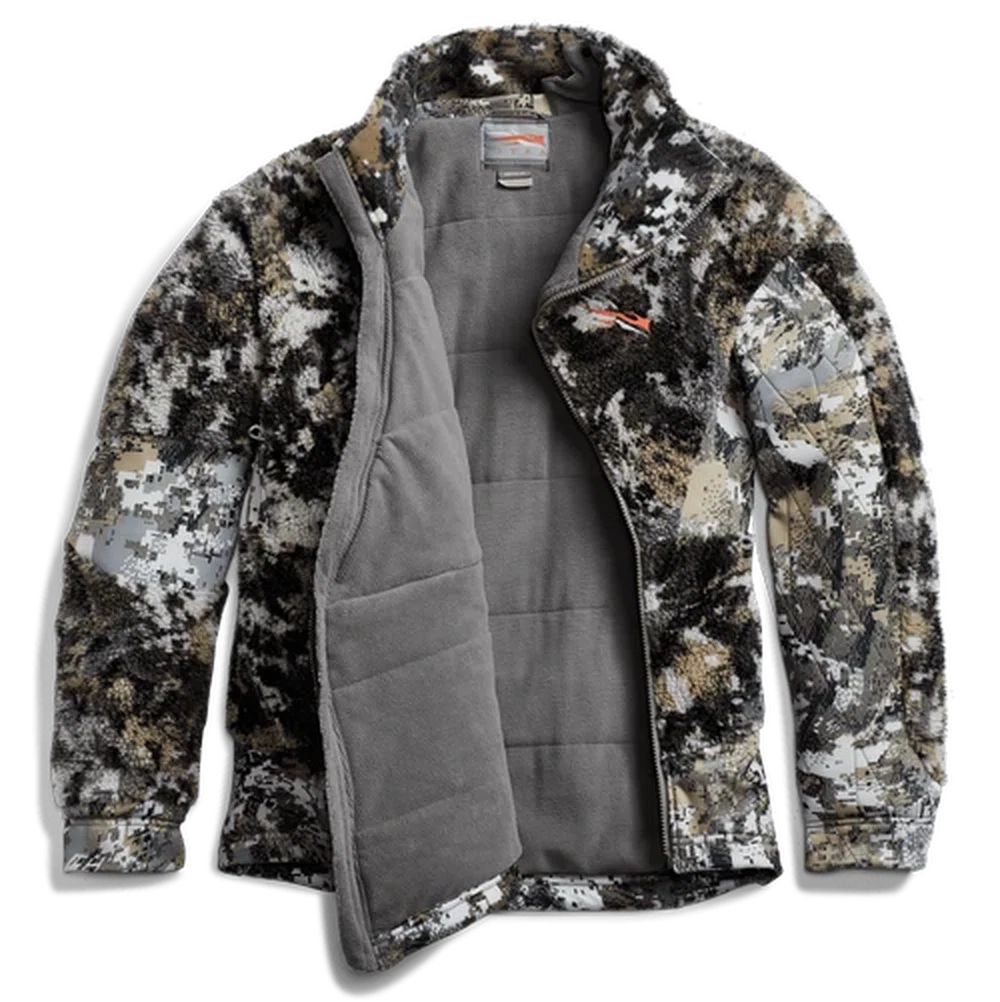
Via sitkagear.com
Not only that…
The outer fleece is optimized for bowhunting (more on that below).
They remove excess bulk from key areas, such as the bending portion of the arm (for drawing), the inner sleeve (for clean release), and the bottom of the jacket.
Did you know?
Sitka Gear is one of the best brands for winter hunting apparel, founded in 2005. You can’t go wrong with their top-of-the-line hunting clothing.
2. Deadly quiet:
The Fanatic is the quietest jacket on our list.
The newest Fanatic is 2x quieter under brutal winter conditions than the previous one.
Unlike the old Fanatic, where the deer may hear rustle sounds of your coat from 20 yards. The newest version cuts that distance in half, down to 10 yards.
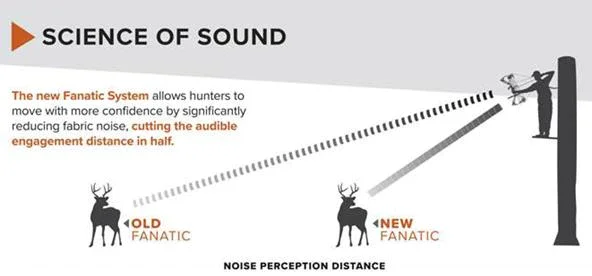
Via sitkagear.com
What… 10 yards?
Yes, taking a shot from 10 yards is much closer and easier than from 20 yards.
Just grab some of this outerwear and improve your chances of tagging a deer this season.
But how does it do that?
The Fanatic cuts down the noise by:
- Adding quiet YKK zippers
- Replacing all buckles and plastic parts with a hook system
- Incorporating a low profile hand muff
- Featuring hand warmer pockets
3. Optimized for drawing cycle:
Sitka designed the Fanatic jacket from day one with whitetail bowhunters in mind.
Innovative diagonal-zip design
Instead of a straight zipper from top to bottom, the Fanatic features an innovative diagonal zip, leaving roomy space for a built-in hand muff.
No other jacket has a comparable unique zipper design like this.
The muff sits tucked behind the Windstopper material. Just toss some hand warmer sachets into it to get some instant warmth. It’s a really nice feature to have.

Innovative diagonal-zip design - Via Amazon.com

handy muff - Via Amazon.com
This comes as a surprise:
It’s genuinely impressive how toasty the muff is. You don't need to wear hunting gloves once you put your hands in the muff.
It allows you to keep your hands warm when not shooting, but have them ready and glove-free for a bare hand release. Who doesn’t love easy, accurate, and fast shooting?
Optimal for bow string clearance
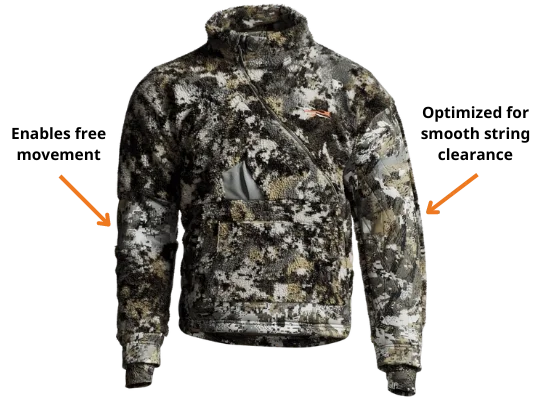
Via sitkagear.com
This winter coat is optimal for bow string clearance.
The left arm sleeve enables smooth arrow clearance, while the right elbow eliminates bulkiness for unrestricted movement.
The result:
You don’t feel the constraint in your arm when drawing the bow.
Wearing it is as comfortable as a pair of old worn-in shoes.
Handy Pockets
Instead of just 2 small pockets like a typical jacket, the Fanatic comes with one big front cargo pocket for storing snacks, grunt calls, bow releases…
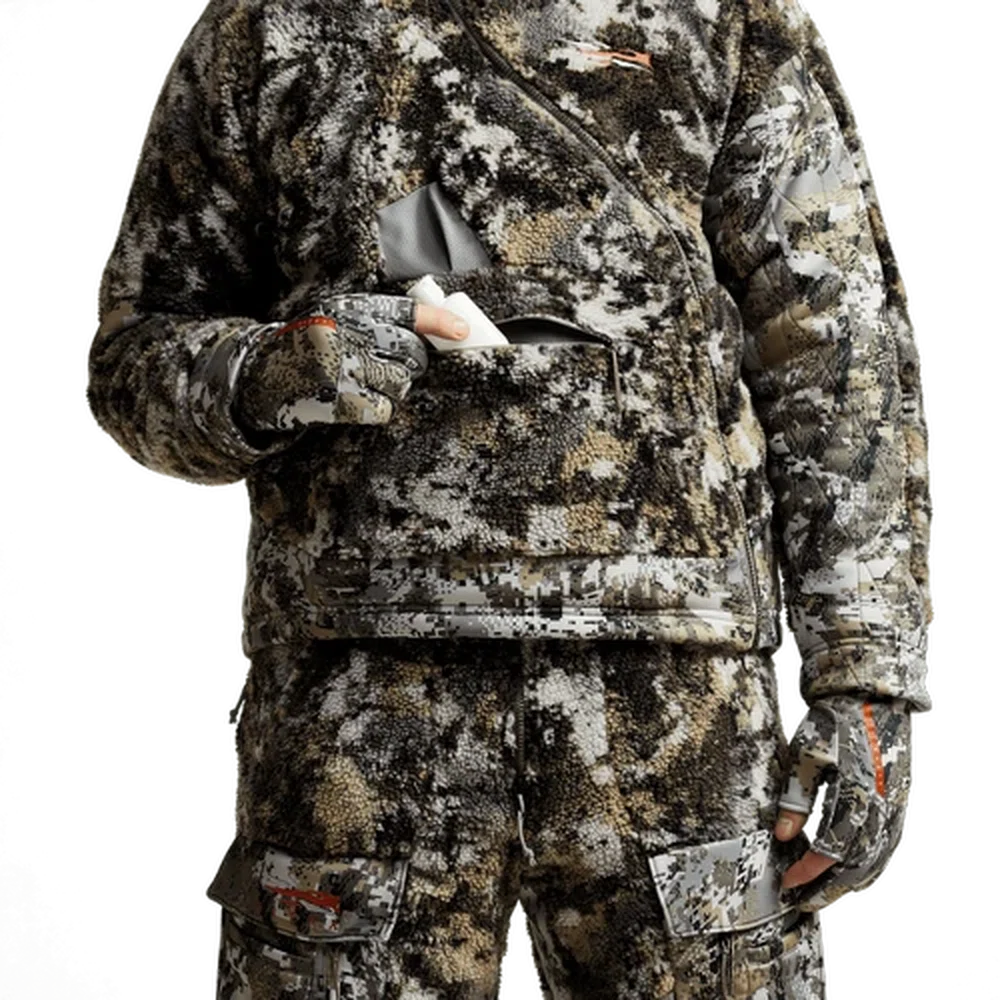
Big front cargo pocket - Via sitkagear.com

Handy chest pocket - Via Amazon.com
There’s more:
The magnetic chest pocket is pretty handy for storing small gear, such as a rangefinder, compact binos, cell phones, monoculars...
And, you don’t need to unbuckle anything, which is great for reducing noise.
Magnetic collar
I love the Collar which features a magnetic closure. It keeps the collar out of your way when releasing the string.
Safely add layers on the stand
Imagine you’re staying up on a stand, the temperature drops down below zero, and you need to add an outer layer for extra warmth…
Typically using a standard jacket, you’d have to disconnect the safety harness putting on the coat.
Wearing the Fanatic, you don’t need to detach the harness.
Open the Constant-Connect Port, put the coat on, and close the port. It’s that safe and easy.

put the coat on without disconnecting harness (Via Amazon.com)
Not only that:
The magnetic closure behind your neck protects you from any wind, water, and cold that comes in from behind.
How’s the fit?
The camo hunting coat is pretty roomy for layering underneath. Just make sure to size up for the base and mid-layers.
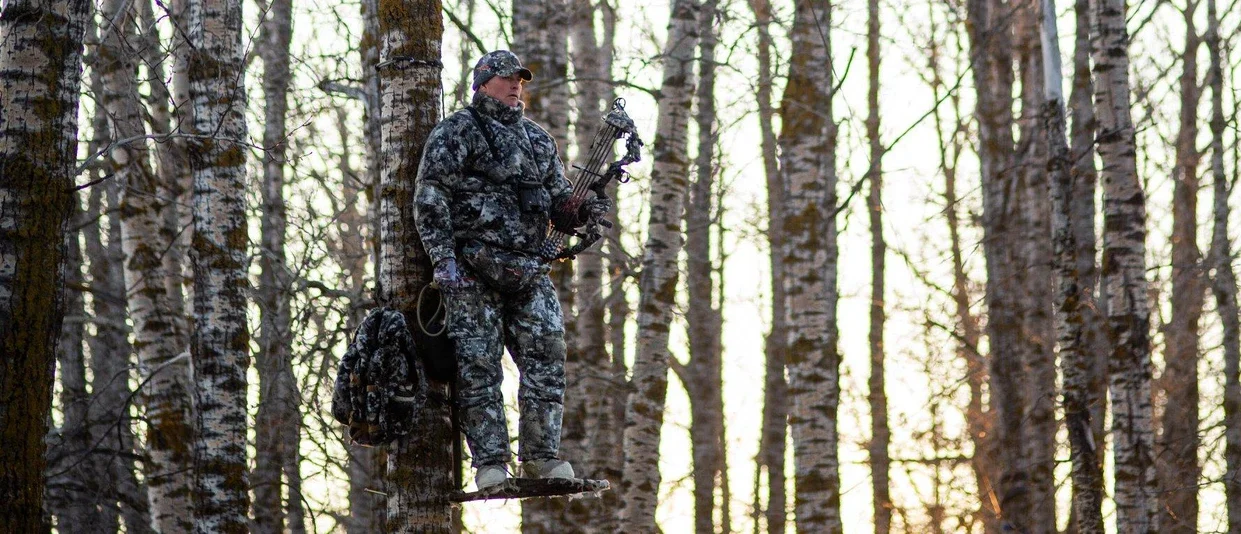
Drawbacks:
Not waterproof
The Fanatic is water resistant but not waterproof.
It’s ideal for cold and mostly dry weather. You should pick the Sitka Incinerator coat if you hunt in high-humidity and wetter areas.
Bulky
The Fanatic is perfect for treestand hunting.
It’s hard to compress down into your pack if you're a hunter on the move.
No hood
Although the collar protects your neck from the bitter cold, I wish it had a hood for extra coverage.
Collects burrs easily
The fleece exterior collects burrs easily. But getting rid of them isn't a big deal.
Pretty pricey
Yep, it’s not cheap for a non-American-made jacket. It’s even more costly than a beginner bow package.
However, if you trade off the cost for the toasty warmth, comfort and enjoyment you can have out in the field, it’s worth every cent.
Pros:
- Extremely warm, and windproof
- Deadly quiet
- Durable
- Lightweight
- Comfortable
- Optimal design for bowhunters
- Handy pockets
- Easy to add layers without detaching your harness
Cons:
- Not waterproof
- Bulky
- No hood
- Pretty pricey
2. Kuiu Super Down Burner Parka:
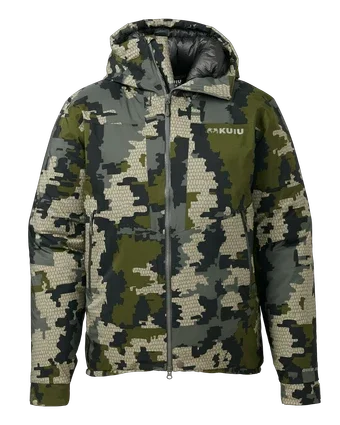
Via kuiu.com
The KUIU Super Down Burner is the warmest packable parka on the market.
It’s more packable, waterproof and costly than the Sitka Fanatic.
If you plan to hunt elk at sub-zero temperatures in Colorado, you shouldn’t go out without one.
Best match: Kuiu Gale Force Pants
Key features:
1. Built-to-Lock Warmth:
The Kuiu Burner is the best outer layer for extremely cold climates.
The cool thing is that it keeps you as warm as an oven, even in the coldest weather (-40 degrees) conditions, like Alaska.
How?
Premium box baffle exterior
The Burner’s design is like a body-fit version of a “sleeping bag”.
Instead of using conventional stitch-through baffles which allow cold to seep in, the KUIU Burner goes with the box baffle design, retaining much more heat and warmth.
Put it on, and you’ll fall in love with such a warm and toasty jacket, even during the harshest of conditions.
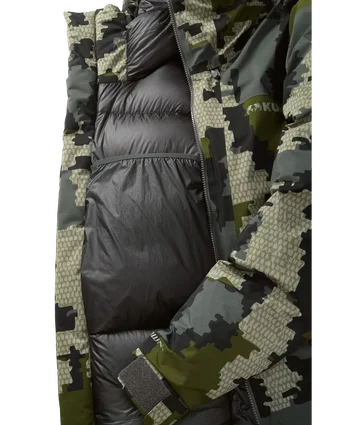
box baffle exterior (Via kuiu.com)
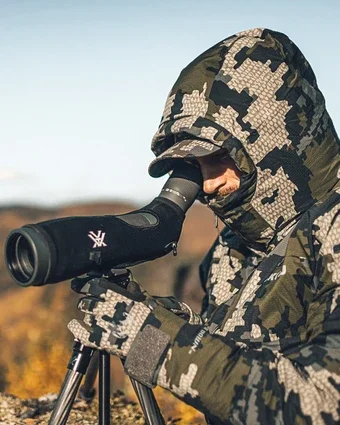
Built-to-Lock Warmth (Via kuiu.com)
Twice the warmth
This is the ONLY JACKET with EMBEDDING DOWN material.
While the Fanatic's Primaloft (synthetic) material is heavy, less warm, and hard to compress, the down fabric of the Burner is lighter, warmer, and more compressible.
The Quixdown insulation of the Burner is double that of the previous Super Down coat.
It translates to 2x the warmth.
But wait… doesn’t the down material stop working when it’s wet?
Yes, but the proprietary Quickdown is treated to shed moisture and keep you bone dry whilst also trapping heat in during wet conditions.
The result:
The combination of the box baffle construction and the Quixdown insulation keeps the warmth in and cold out, making it great for stationary hunting.
Did you know?
KUIU conducts hundreds of in-house tests for Quickdown materials before being certified by The International Down and Feather Laboratory (IDFL).
They must be doing something right.
2. Fully waterproof and windproof:
Thanks to the Dermizax Waterproof outer layer, the parka is 100% WATERPROOF AND WINDPROOF.
It insulates from the wind, which is the main cause of the cold. In addition, you’re protected from getting wet in the coastal rainforests of Alaska.
Once you put it on, even bowhunting in 0 degree weather with a blowing wind chill is super fun.
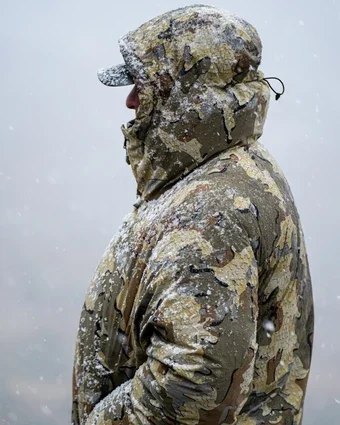
Fully waterproof and windproof (Via kuiu.com)
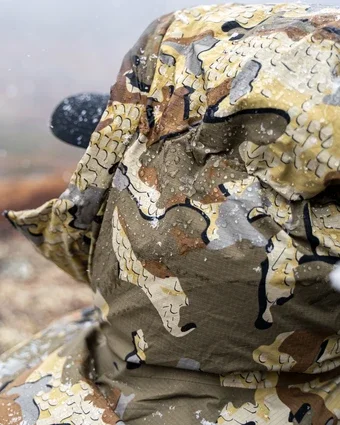
Via kuiu.com
3. Packable:
Is it lightweight?
It’s half the weight of the Sitka Fanatic, whilst still remaining warm, durable, and packable.
In fact, this is the lightest hunting jacket for cold weather on our list, weighing only 28 oz.
Despite the fact that the Quickdown material is pretty bulky, compressing it to a stuff sack is like a piece of cake.
You can carry it around all the time.
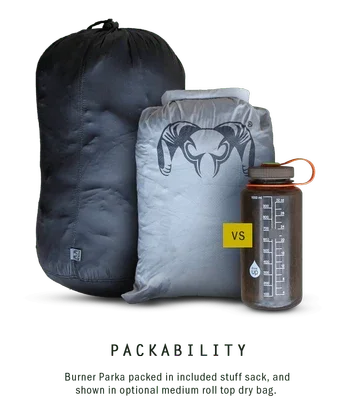
Via kuiu.com
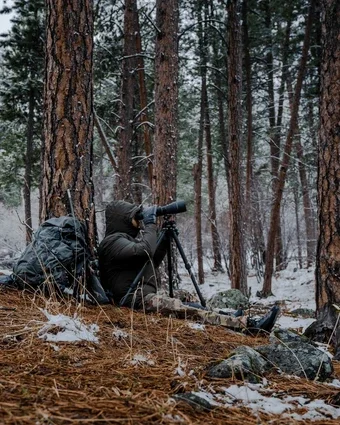
Lightweight and durable (Via kuiu.com)
Is it durable?
The 30D Ripstop Nylon Stunner Stretch face fabric maximizes durability.
Let’s say you have it out in a downpour, or busting through the bush, it still remains like new without even a scratch.
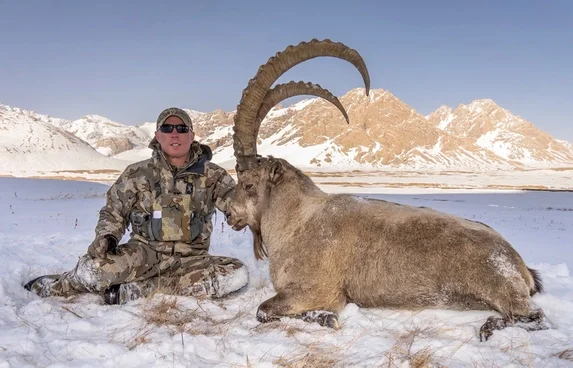
KUIU’s Justin Shaffer's battling deep snow and cold temps above 13,000 feet
Drawbacks:
Less quiet
It’s less quiet than the Sitka Fanatic. But it won’t be any louder than your footsteps on the snow.
Not a big deal, though.
Super expensive
Like the Sitka Fanatic, the price tag is definitely on the higher side for a non-American-made coat.
However, if you head out for a mountain hunt and need an outstanding winter hunting jacket to withstand the frigid cold and wet conditions, this jacket will give you peace of mind.
Pros:
- Insanely warm in sub-freezing conditions
- 100% waterproof and windproof
- Unmatched materials
- Premium design
- Lightweight
- Packable
- Durable
Cons:
- Less quiet
- Expensive
3. Scentlok BE:1 Divergent Jacket:

Via Amazon.com
The Scentlok Divergent Jacket gets the job done nicely without compromising on exceptional warmth, comfort, and scent blocking.
Compared to the Sitka Fanatic it has a less ergonomic design, but does offer a similar hand muff at a cheaper price.
It’s a must have piece for treestand bowhunters hunting mid to late season.
Best match: ScentLok BE:1 Divergent Hunting Pants
Key Features:
1. Exceptional Warmth:
Wearing this winter hunting coat feels like hanging out in your living room. You can sit on a treestand for much longer on cold days.
What insulation is the Divergent using?
Unlike the Primaloft silver of Sitka Fanatic, the Divergent integrates Primaloft gold, the top-of-the-line insulation.
The gold version adds 20% more warmth than the silver while cutting the weight.
Not only that…
The body mapping system strategically distributes insulation to lock the heat in the key areas.
They place heavier insulation at the core, chest, and back areas while reducing it in the arms.
Why? Since your arms need room to move and a wide range of motion for drawing a bow.
Hunting mid-rut when the temperatures drop down to zero is no longer a big deal.

Via Amazon.com
Is it windproof?
Yes.
Despite the Divergent not having a windbreaker membrane, the perfect combination of Primaloft gold and insulation prevents the wind from getting through.
And guess what? The blended fabrics of wool shell and microfleece work without making noise.
So you don’t worry that the wind will rustle the jacket, and spooking any deer.

Via Amazon.com
Is it waterproof?
Unfortunately no. The Divergent is NOT 100% WATERPROOF.
The Precip-X™ technology does allow water to roll off easily and keep you dry though.
It comes in handy for slight sudden rain on the hunts. It’s generally a trade off between being waterproof or having quieter fabric.
2. Bowhunter-friendly comfort:
Like the Sitka Fanatic, the design of the Divergent is bowhunter friendly.
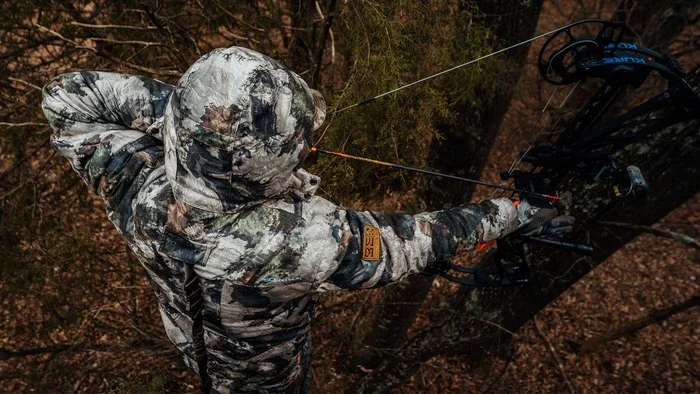
bowhunter friendly
Unique half-zippers
The winter hunting coat features 3 half-zippers:
- 1 on the front
- 2 on the sides
Why do half-zippers matter?
Instead of the full zipper of a typical jacket, the front half zipper leaves ample space for a hand warmer and kangaroo pouch.
You might be wondering:
Is it hard to get it on and off while pulling it over the head?
Don’t worry; the Scentlok Divergent covers you with the extra 2 side-half zippers.
They not only make it easier for taking it on and off but also can be used to release heat or moisture if you find yourself getting too hot.
Sounds good?
Similar big pouch and hand warmer
Like the Sitka Fanatic, the Divergent has a front hand warmer and a huge front compartment.
The big ample hand warmer keeps your hands nice and warm whilst waiting for that big buck to stroll in.
The best part:
The pouch is large and convenient.
You can store your binoculars in there without needing a bino harness. The top loading stops it from popping out, keeping your binos ready for use.
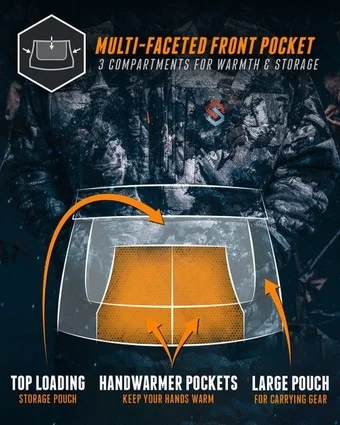
Via scentlok.com
Handy chest pockets
The Scentlok features 2 handy zipper pockets on the chest with built-in aerogel.
Loading up with a ton of small gear, such as a phone, wallet, monocular… is no longer a headache.
Wait… what is aerogel?
Primaloft® gold aerogel technology works like a shield to protect the inside heat of electronic devices from outer cold, extending its life for all day hunt.
Let's say you’re sitting on a treestand at midday and putting your phone in your pocket.
Typically using a winter jacket, the phone battery drains more quickly due to the cold temperature. However, when placed in the Divergen, the battery level stays longer.
The result: Sitting all day in a hunting spot with your phone becomes a non-issue.
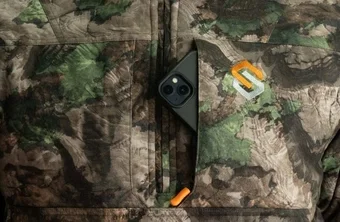
Primaloft® gold aerogel keeps phone battery lasting longer (Via scentlok.com)
Is the hood removable?
Unlike the Fanatic, the Divergent has a removable and adjustable hood with a built-in neck gaiter and facemask.
The hood protects your head from chilly winds and hides the emitted odor from your skin, mouth, nose, and hair.
Meaning you’re less likely to alert the deer's sensitive nose.
Removing the hood is like a piece of cake if you prefer to hunt without it.

removable hood without limiting your sight (Via Amazon.com)
Does the hood limit your sight?
Nope, once cinched up, the hood pivots whenever you move your head.
Imagine how annoying it is when you hear something on the side, turn your head, and see the hood inside instead of the animal in question.
This takes away the typical impracticalities of hood wearing.
Is it heavy?
Not at all. The jacket looks bulky due to thick insulation, but it’s not heavy.
Packing it out to the stand is not an issue. And wearing it feels like you’re bundling up in bed, but without the bulkiness.
3. Unmatched Scent Protection:
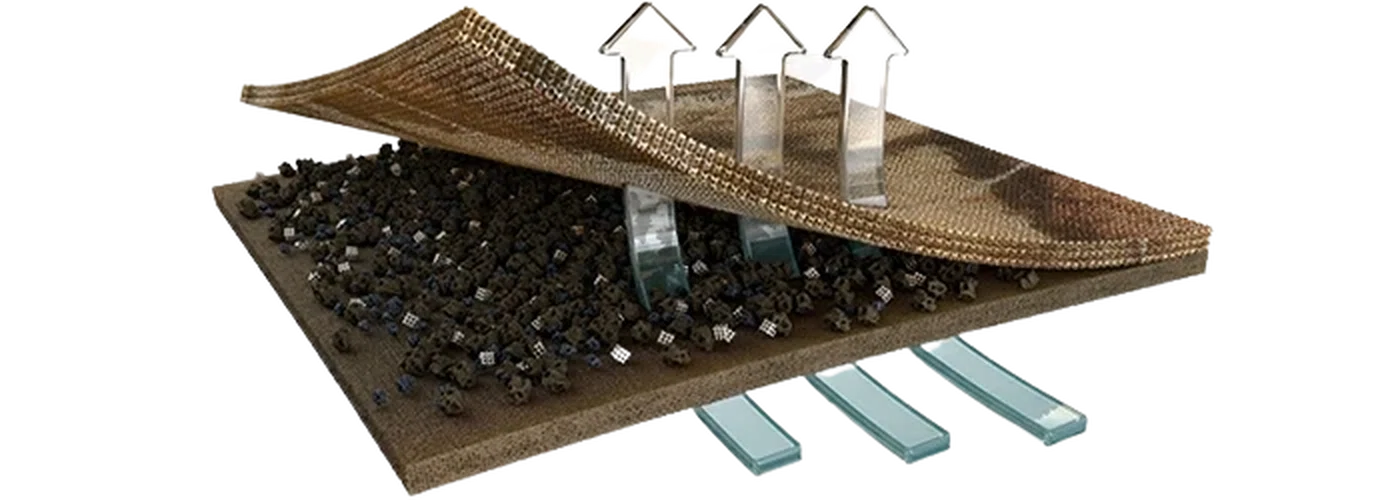
odor controlling technology
The Scentlok integrates an exclusive Carbon Alloy® technology. It traps your body odor reducing risk of getting noticed by deer.
How?
This patented technology combines a high density of treated carbon, activated carbon, and zeolite to maximize odor absorption and lock it there.
It stops your scent from spreading out when the breeze flows across you.
It goes a long way towards stopping deer from getting spooked due to inadequate scent control.
Did you know?
Scentlok Technologies has been the world's top brand of winter hunting apparel since 1992.
Their proven, unmatched, proprietary activated carbon technology is hard to beat.
Drawbacks:
Non-camo facemask
What a shame that the built-in facemask doesn’t use camouflage.
Half zipper design
Let's face it: Putting the jacket on and off with half zippers is far less convenient than with a full zipper.
The diagonal zip of the Sitka Fanatic is unbeatable though (check above).
Pros:
- Exceptional warmth
- Windproof
- Water repellant
- Big hand warmer and huge front compartment
- Quiet
- Removable hood with built-in neck gaiter and face mark
- Safety harness port at the back
- Elastic cuff for bow hunters
- Lightweight
- Controls your scent well
Cons:
- No camo facemask
- Bulky
- Not waterproof
- Hard to put on and take off
4. First Lite Sanctuary 2.0 Insulated Jacket:

Via Amazon.com
The First Lite Sanctuary 2.0 Jacket is an upgrade from its predecessor, with upgraded fit, fabrics, and utilities.
Its warmth and quietness is comparable to the Fanatic, but the fit is better.
You’ll stay out longer on windy days (10 mph winds for instance), and improve your odds of a successful hunt even if it's below 40 degrees out.
Best match: Sanctuary 2.0 Insulated Bib Pants
Key Features:
1. Maximized warmth:
The Sanctuary 2.0 covers you with 6 layers of fabric and insulation to keep in your body heat.
The ultimate design has only one clear goal: to protect you from the chilling cold.
Let me tell you:
A typical winter jacket does a great job of keeping you warm, except when it’s windy.
That’s when the Sanctuary 2.0 comes into play. The windproof membrane of the Sanctuary kills the wind, while the 37.5 Synthetic Insulation traps the heat in.
Put it on, and you’ll never have an issue with the wind again.

6 layer fabric (Via Amazon.com)
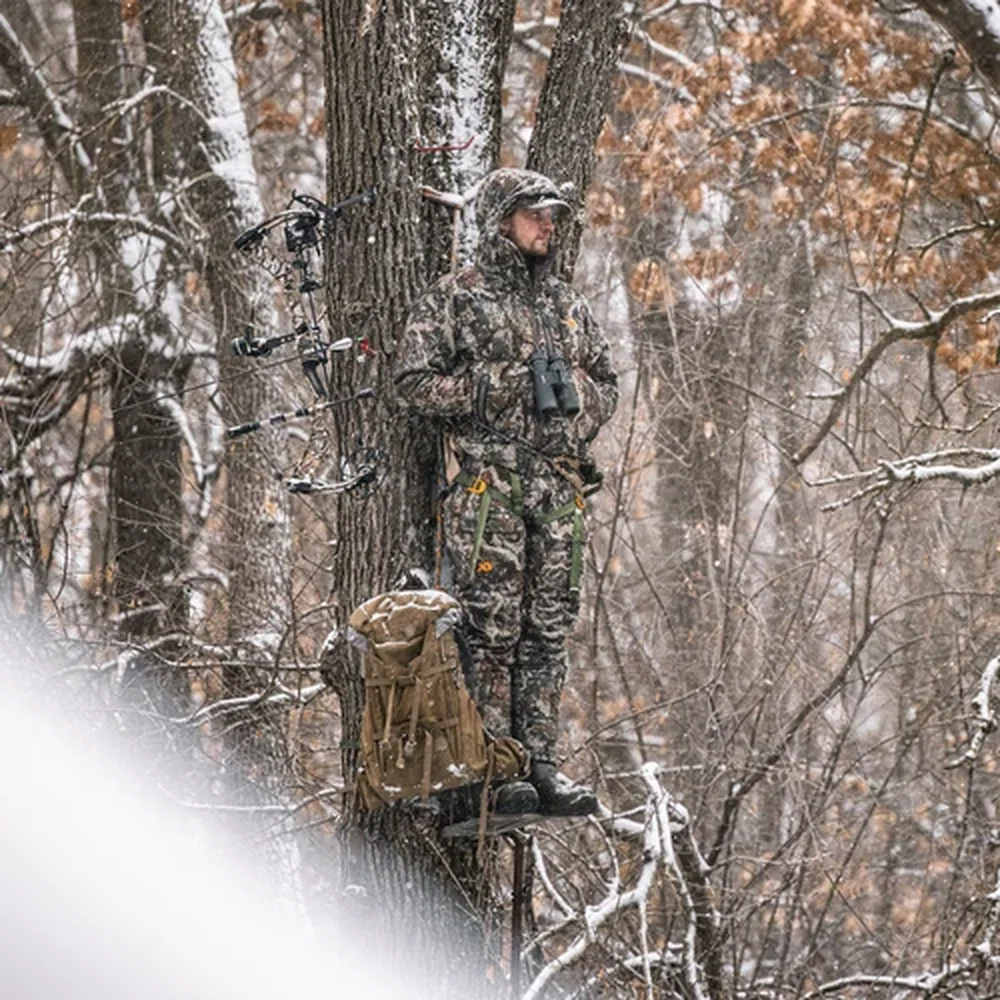
Maximized warmth (Via firstlite.com)
So what is 37.5 Synthetic Insulation?
Basically, the 37.5 is an exclusive blended material of DWR Down, 37.5 fiber, and synthetic materials.
It is like a “bodyguard”, keeping your body heat inside, while letting your moisture go out.
The result:
It regulates your temperature, improves your breathability, and limits overheating when sitting up on the stand.
How does it repel water?
The water-repellent outer layer lets the water roll off it, keeping you dry in slight to moderate rain. However, it’s not waterproof. You need an additional layer if hunting through a heavy downpour.
2. Utilized Shooter’s cut:
Like the bowhunter-friendly construction of the Sitka Fanatic, the Sanctuary 2.0 is utilized for treestand hunters, with its:
- Treestand Pass-Thru
- Turret Hood
- KitLink Zippered Pass-Thru
- Enormous collar
- Insulated hand pockets
- Stretched sleeve for free range of motion
Deadly quiet
The cool thing is that the fabric is pretty quiet.
You’re free to draw your bow with no noise, and drop deer down, without it ever hearing your movement.
3. Great fit:
Wearing this winter hunting jacket is pretty comfy.
Instead of picking a size up, just pick your true size. Don’t worry about it coming too tight anymore.

Utilized Shooter’s cut (Via Amazon.com)

Via Amazon.com
Drawbacks:
Unremovable hoods
You can’t remove the hood. But it does fall away nicely when not in use.
No built-in hand warmer
This jacket has only 2 zipper pockets for keeping your hands warm.
I tend to prefer the big front kangaroo hand warmer that other models offer.
Bulky and heavy
The Sanctuary 2.0 is much bulkier and heavier (58 oz) than the Fanatic due to the thicker insulation.
Rolling it up on the way in and out of the bush is not so easy.
It’s probably best to not put it on until you get to the stand, or you’ll sweat like a pig.
Pros:
- Windproof
- Bowhunter friendly
- Dead silent
- Durable
- Water resistant
Cons:
- Not made in the USA
- Unremovable hood
- Bulky
- Not waterproof
- No kangaroo pouch hand warmer
5. Badlands Pyre Jacket:

Via Amazon.com
The Badlands Pyre is the best budget friendly jacket for cold weather.
It keeps Midwest hunters pretty warm and comfortable from -15 to 40 degrees.
Best match: Badlands Pyre Bibs
Key features:
1. “Blankety” Warmth:
This outerwear covers you with “blankety” warmth and “slipper-like” comfort.
Like the Sitka Fanatic’s insulation, the Pyre is embedded with PrimaLoft® Silver insulation. It also comes with a high loft fleece lining.
Staying out for hours in a hunting stand becomes much more comfortable.
Where is the fleece placed?
The fleece material is heavily placed in:
- Inner lining
- Hand Warmer Pockets
- Hood
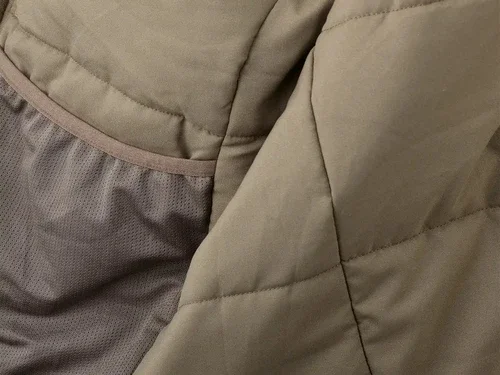
"Blankety” warmth (Via badlandsgear.com)
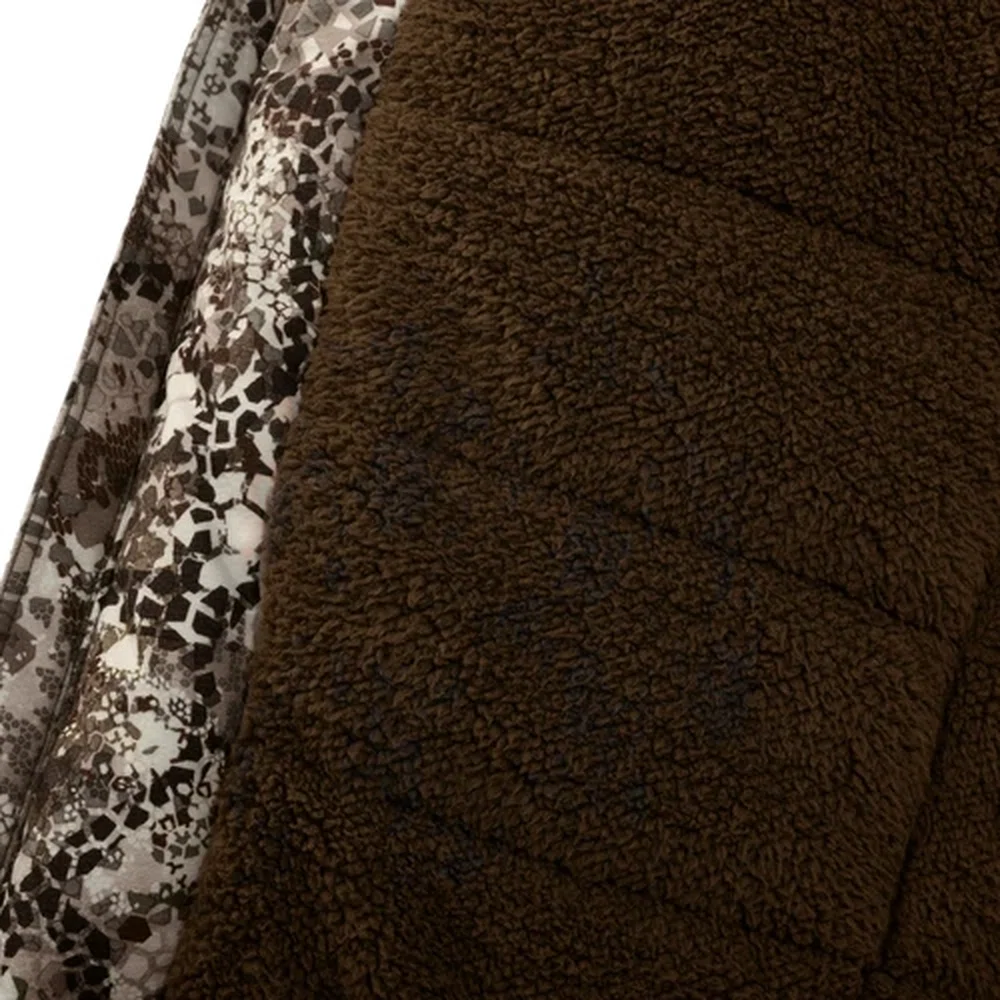
fleece lining (Via badlandsgear.com)
Even more:
The adjustable velcro cuff seals the cold out and keeps the heat in.
If you’re not too cold prone, wearing this jacket at -5 degree temperatures with wind chill is no problem.
Here’s the deal:
Fully waterproof and windproof
Yes, you read it right. 100% waterproof and windproof.
You can’t find a coat as amazing as this at such a reasonable price.
The waterproof breathable membrane combined with C6 DWR fabrics stops water, wind, and snow.
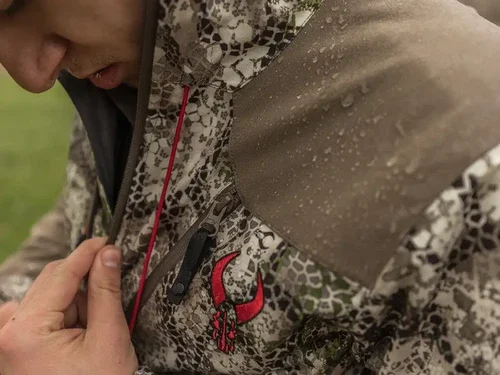
Via badlandsgear.com
Slipper-like Comfort:
Wearing this jacket is pretty comfortable. The sleeves are not tight nor too ample, but fit the arms well.
You won’t feel any restriction when drawing your bow.
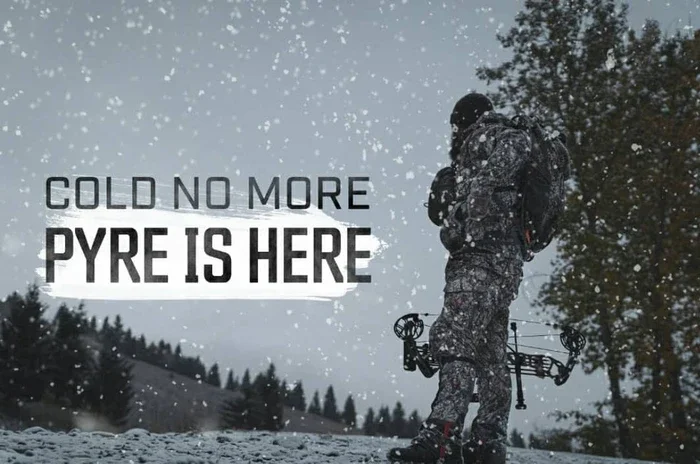
2. Utilities for bowhunters:
The tether exit port assists with treestand climbing, while the smooth sleeves with good elbow space makes the movement of drawing your bow easy.
The garment also includes 4 handy pockets.
Unique utility chest pocket:
You’ll be impressed with the built-in rangefinder lanyard in the chest pocket.
It’s pretty handy to prevent you dropping your rangefinder or compact binos. So if you leave your binocular harness at home, no problem.
However, there’s only 1 cord, so you can’t attach multiple devices.
2 big fleece pockets
Despite the fact that it doesn’t feature a big kangaroo hand warmer, the 2 low fleece pockets do keep your hands cozy.
Bear in mind that the pockets are placed at a low position. It requires a little extra arm movement when you go from casual waiting to ready-to-draw.
3. Reasonable price:
The Badlands cover your back with their lifetime warranty. You can’t go wrong with them.
The price and the warranty really save you from paying an arm and a leg, especially for such a decent jacket.

Via Amazon.com
Drawbacks:
No hood
The jacket has no hood or neck gaiter to protect your head from breezes above the shoulders. You’d better get additional coverage up there.
A little bulky and heavy
It’s on the heavy side due to the heavy insulation, weighing in at 49 oz.
However, once you’ve layered up properly, you’ll be ready to battle through blizzards.
Pretty loud material
The material is pretty loud when it gets cold. Keep that in mind.
No double zippers
The zippers close only in a single direction. I wish they featured 2 way zippers for extra convenience.
Pros:
- “Blankety” warmth
- Slipper-like comfort
- Chest pocket with built-in rangefinder lanyard
- Odor resistant
- Fully waterproof and windproof
- Reasonable price
Cons:
- Loud
- A little heavy and bulky
- No hood and neck gaiter
- No 2 way zippers
How to Choose a Winter Hunting Jacket:
What do you need to consider when looking for a winter hunting coat?
In my experience, consider these vital factors:
Materials
There’s a day and night difference between cheap and high-quality materials.
How to tell whether the jacket is warm enough for cold-weather hunting?
Believe it or not, reading the elements and recommended conditions on the clothes tags is the easiest way to determine how warm your jacket is.
You'll stay nice and warm all day if it is made of one of these common fabrics:
- Wool
- Down
- Primaloft
Wool
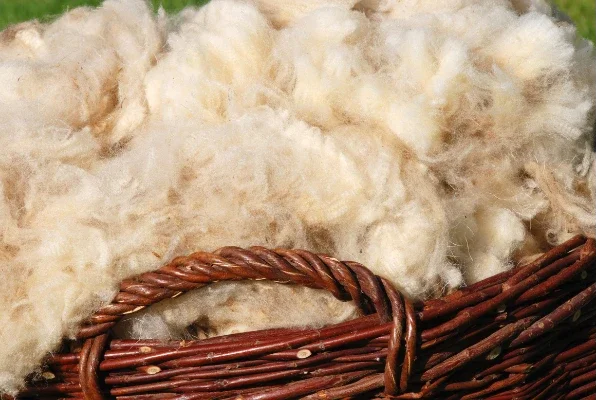
Wool is the warmest and most environmentally-friendly fiber. Interestingly it works like a vacuum.
It traps your head inside and insulates the cold out.
Additionally, it’s also a breathable fabric, regulating your body temperature while wicking away moisture from your skin.
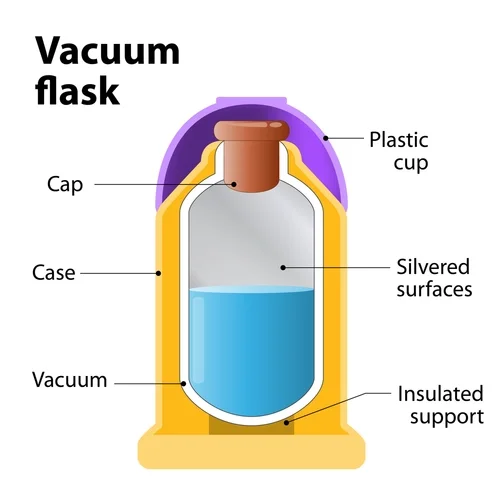
What are the disadvantages of wool?
The disadvantages of wool are that it is heavy, non-machine washable, and expensive.
It means it can be less versatile for hunters on the move.
Down
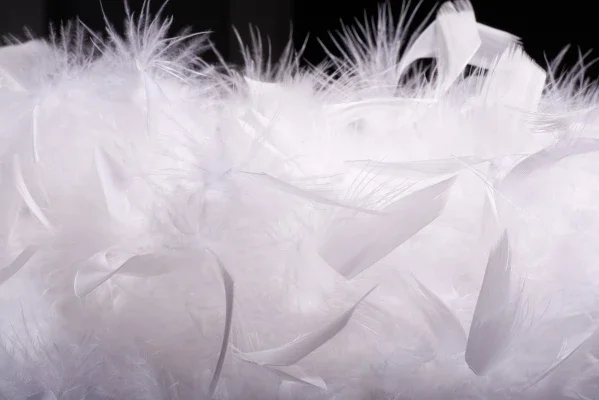
Down is the 2nd best natural material for winter hunting jackets.
Like wool, it absorbs your body heat and keeps you cozy no matter how cold it is.
Besides that, it’s breathable and comfortable for all-day wear.
In fact, it’s the most lightweight and packable fiber for outdoor activities.
What are the disadvantages of down?
Despite its positives, there are still some cons to using down material, such as:
- Takes a long time to dry
- Absorbs water and moisture from your skin
- Pricer than Primaloft below
PrimaLoft (Synthetic)
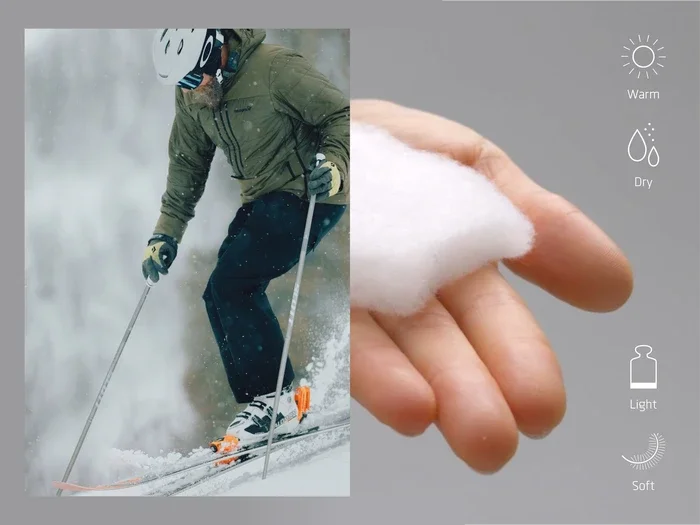
Via primaloft.com
Primaloft or Synthetic is an artificial alternative to down material.
It holds the advantages of down, including super warmth, breathability, and comfort, but at a lower price.
Even more: Primaloft repels water in snow and wet conditions and keeps you totally dry, which down material struggles to do.
If you’re hunting in high-humidity areas, Primaloft is the best fit.
Typically there are 3 versions of Primaloft: gold, silver, and black.
My advice: opt for the Primaloft gold version as it’s the highest level of quality.
What are the disadvantages of Primaloft?
Primaloft can’t beat Down material for overall warmth.
Putting a down hunting jacket on is much warmer and toasty than a synthetic one.
So which material is the best?
Well, that really depends on your budget. Higher quality material equates to a higher price tag.
In my opinion, the Primaloft fiber is the best for the money.
It’s toasty warm, waterproof, and windproof without costing an arm and a leg.
Wait… what do you mean windproof and waterproof?
Windproof
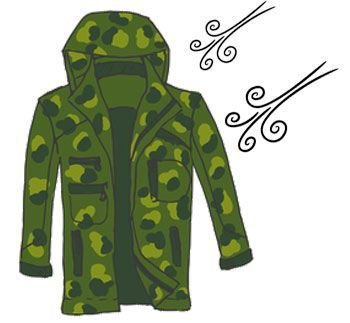
Even when the temperature is not that low, you’ll still feel cold in severely windy conditions.
The trick is preventing the wind from piercing through your clothing.
How?
Opt for a jacket featuring a windbreaker membrane that blocks the wind out.
Typically high-end hunting jackets for cold weather integrate windproof fabrics with heavy insulation to break the chilly wind.
Waterproof

Is there a sure way for you to tell if it will rain on your trip?
You never know when you’ll get caught in the pouring rain, especially in ever changing mountain climates.
When you do, you’ll be glad you opted for a jacket with a water-repellent coating or one made from waterproof fabrics.
But wait… water-repellent vs. water-proof, are they different?
Yes, they’re different.
A water-repellent jacket withstands light to moderate rain pretty well but can’t endure sudden downpours.
That’s when a waterproof coat comes into play, surviving through heavy rain and keeping you dry on the inside.
How about the jacket’s utilities?
Additional Features
Don’t underestimate the other utility functions, such as:
- Handy chest pockets
- Kangaroo pouch muff
- Removable hood, neck gaiter, face mask
- Safety harness port
Although they don’t make or break your hunting trip, they obviously add those extra comfort and practicality factors that can keep you out hunting for longer.
Price wise

Unless you’re on the Forbes Billionaires list, price is important in choosing the best hunting outerwear for cold weather.
Their prices range from $100 right up to $700, depending on the brand and quality.
Which price range should I pick?
If you’re too not cold-prone or hunting in milder areas, a budget-friendly jacket like Badlands Pyre is more than enough for this season.
However, if you’re a “die-hard hunter” and serious about your investment, a top-of-the-line jacket like Sitka and Kuiu would be your best bet.
In the end, you get what you pay for.
Now what?
Our pick for the best hunting jacket for cold weather is the “Sitka Fanatic Jacket”.

Via Amazon.com
Here’s why it’s the most trustworthy choice for this late season:
- Keeps the toasty warmth in while sealing the chilly wind out
- Allows you to comfortably hunt for hours longer
- Windproof
- Water repellant
- Deadly quiet
- Innovative diagonal-zip design
- Toasty warm muff
- Optimal design for bow clearance
Your turn: Which jacket do you prefer, Sitka or Kuiu? Let us know below.
And don’t forget check out some other hunting gear for keeping out that frigid cold weather:
